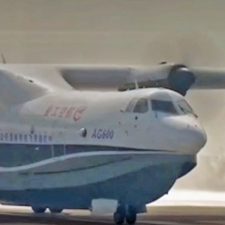Above: screen grab from the BBC video showing (through dense smog) the AG600 taxiing after its first flight December 24, 2017.
China’s new amphibious aircraft that can scoop water and drop it on wildfires made its maiden flight December 24 at Jinwan Civil Aviation Airport in Zhuhai, Guangdong.
(Note: the original BBC video became no longer available. On March 15, 2021 it was replaced with the video below.)
The AG600 can carry up to 3,000 gallons of water, and like the CL-215/415 and Air Tractors it can scoop water from a lake and drop it on wildfires. When not fighting fires it can hold 50 passengers in a military or civilian role and has a range of 5,500 km (3,418 miles). It has four turboprop engines, can handle a wave height of two meters, and will have a maximum speed of 354 mph (570 kph, 308 knots).
In 2015 The Coulson Group, operator of the two huge Martin Mars water-scooping aircraft, trained 14 test pilots from China who were expected to be the first to fly the AG600 (also known as the TA-600). The training included ground, water taxi, flight, scooping, and dropping water. The pilots went through classroom and hands on training using Coulson’s Hawaii Martin Mars aircraft, actually taxiing and flying the huge flying boat.
Thanks and a tip of the hat go out to Micah.
Typos or errors, report them HERE.


Very interesting addition to the world’s aircraft inventory. Quite comparable in size and other specs to the C-130. It’s been so long ago that I can’t remember the source, but didn’t Lockheed once do an engineering/marketing study on an amphibious version of the Hercules?
The issue with all the amphibious water scooper types is that for US service at least, the weapon of choice has become retardent solutions and not plain water, so the “scooping” ability seems to be a somewhat of a sidenote.
Glad to see a clean sheet aircraft though, from any manufacturer/country.
There seems to be very little innovation in the US industry … sticking a glass cockpit into the 63-year-old C-130, “talking about” hanging new engines on the 64-year-old B-52, or figuring out how to make the lavatories on the 50-year-old B-737 smaller in order to cram in a couple more seats. (OK, old man rant mode off), Merry Christmas and a very Happy New Year, Bill and all the readers of Fire Aviation.
This aircraft will have huge military uses, also (maybe primarily), supplying Chinese island expansion in the South China Sea.